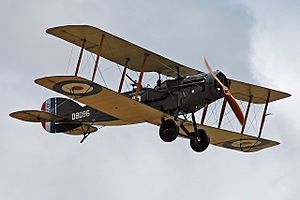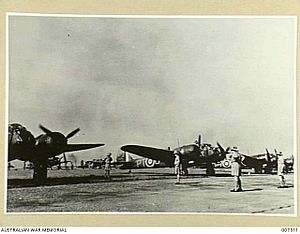No. 62 Squadron RAF facts for kids
Quick facts for kids No. 62 Squadron RAF |
|
|---|---|
| Active | 8 August 1916 – 31 July 1919 3 May 1937 – 15 March 1946 1 September 1946–10 August 1947 8 December 1947 – 1 June 1949 1 February 1960 – 31 January 1963 |
| Country | |
| Branch | |
| Motto(s) | Latin: Insperato ("Unexpectedly") |
| Insignia | |
| Squadron Badge heraldry | A meteor |
| Squadron Codes | 62 May 1937 - Nov 1938 JO Nov 1938 - Sep 1939 PT Sep 1939 - Feb 1942 |
No. 62 Squadron was a special unit of the Royal Air Force (RAF). It started out as part of the Royal Flying Corps in 1916. During the First World War, it flew Bristol F2B fighter planes in France. After the war, the squadron was temporarily closed down.
It was brought back in 1937 as the RAF grew stronger. In the Second World War, the squadron went to the Far East. They flew Bristol Blenheim planes from places like Singapore and Malaya. Later in 1942, they got new Lockheed Hudson planes. The squadron then moved to Sumatra, Burma, and India.
After the Second World War ended, the squadron was closed again. It briefly started up once more from 1946 to 1947. At this time, they used Dakota transport planes in Burma and India. The squadron's final role was in the early 1960s. It became a unit that used Bristol Bloodhound missiles.
Contents
No. 62 Squadron in the First World War
No. 62 Squadron of the Royal Flying Corps began on 8 August 1916. It was formed at Filton, in Gloucestershire, England. The squadron received its Bristol F2B fighter aircraft in May 1917. In January 1918, the unit moved to France. They started flying missions from the Serny airfield.
The squadron's job was to fly fighter-reconnaissance missions. This meant they would fight enemy planes and also gather information. The squadron was closed down on 31 July 1919.
The squadron got its first victory on 21 February 1918. This happened near Armentières, France. The unit was sometimes called "The Cheery 62s." On 12 March 1918, they faced Manfred von Richthofen's famous "Flying Circus." This battle resulted in some losses for the squadron.
No. 62 Squadron was one of the last two Bristol F.2 Fighter squadrons. They served on the Western Front. Their planes often flew alongside de Havilland bombers. By the end of the war, No. 62 Squadron had destroyed 76 enemy aircraft. They also forced 85 others to lose control.
Ten flying aces served in the squadron. These included William Ernest Staton and George Everard Gibbons. The squadron's victories came with a high cost. Twenty-eight of its pilots were killed in action. Three more died in accidents. Thirty-two pilots became prisoners of war. Many others were wounded or injured.
No. 62 Squadron in the Second World War
On 3 May 1937, No. 62 Squadron was started again. This happened at Abingdon. They first used Hawker Hind aircraft. In February 1938, the squadron switched to Bristol Blenheim planes.
In August 1939, the squadron was sent to Singapore. By February 1940, they moved to Alor Star in northern Malaya. Japan invaded Malaya on 8 December 1941. The squadron had to move to Butterworth the next day.
An attack on Singora airfield was planned for that day. But Japanese planes attacked Butterworth first. Only one Blenheim, flown by Squadron Leader Arthur Scarf, managed to take off. He bravely attacked Singora alone. His plane was badly damaged, and Scarf was seriously hurt. Despite his injuries, he landed the plane safely. This saved his crew. He died later that evening. Scarf was later given the Victoria Cross for his courage.
Butterworth was heavily damaged by the Japanese attack. The squadron moved to Taiping, Perak. They moved again to Singapore on 19 December. The squadron lost many planes due to Japanese attacks. They then got new Lockheed Hudson planes. In January 1942, they moved to Sumatra.
Six of the squadron's Hudsons attacked Japanese ships. This happened during the Battle off Endau on 26 January. Two of their planes were shot down. The squadron then moved to Java when Japanese paratroopers landed. The squadron worked closely with No. 1 Squadron RAAF. It was then closed down on 20 January 1942. Its remaining Hudsons went to the Australian squadron.
On 30 April 1942, the squadron was reformed. This happened when No. 139 Squadron was renamed. They were based in Calcutta and flew Hudsons. The squadron's job was general reconnaissance. They flew patrols along the coast of Burma. They also looked for enemy submarines. On 18 August, one of their Hudsons chased away a Japanese flying boat. This flying boat was attacking a merchant ship.
From January 1943, the squadron focused on bombing missions. In May, they stopped front-line operations. Their Hudsons were changed to carry supplies. In November, they got Douglas Dakota transport planes.
The squadron helped British forces in the Battle of the Admin Box in February 1944. They also supported Operation Thursday in March. This was a special operation by the Chindits. The squadron dropped many supplies during the Battle of Imphal. They kept flying even during the heavy Monsoon rains.
The squadron took a break from operations in August 1944. They returned to dropping supplies in November. They continued these duties and general transport flying. This lasted until the war ended in August 1945. The squadron was closed down on 15 March 1946. This happened at Mingaladon, near Rangoon (now Yangon), Burma.
After the Second World War
No. 62 Squadron was reformed again on 1 September 1946. This happened at Mingaladon. It was a Dakota squadron once more. This time, No. 76 Squadron was simply renamed No. 62. The squadron then moved to India. It was closed down on 10 August 1947.
The squadron was reformed at RAF Manston on 8 December 1947. Its job was to help with the Berlin Airlift. This was a huge effort to fly supplies into Berlin. The squadron stayed active even after the airlift. It was finally closed down at RAF Oakington on 1 June 1949.
From 1 February 1960 to 31 January 1963, the squadron was based at Woolfox Lodge. It became a unit that used Bristol Bloodhound missiles. This was part of No. 151 Wing RAF.
Aircraft Used by No. 62 Squadron
- 1917–1919 Bristol F2B Fighter
- 1937–1938 Hawker Hind
- 1938–1942 Bristol Blenheim I
- 1942 Lockheed Hudson III
- 1942–1943 Lockheed Hudson III
- 1943 Lockheed Hudson VI
- 1943–1946 Douglas Dakota
- 1946–1947 Douglas Dakota
- 1947–1949 Douglas Dakota
- 1960–1964 Bristol Bloodhound I



